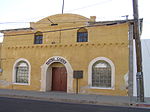Santa Cruz Catholic Church
1918 establishments in Arizona20th-century Roman Catholic church buildings in the United StatesCatholic Church in ArizonaChurches in Pima County, ArizonaChurches on the National Register of Historic Places in Arizona ... and 5 more
Mission Revival architecture in ArizonaNational Register of Historic Places in Tucson, ArizonaRoman Catholic churches completed in 1918Roman Catholic churches in ArizonaRoman Catholic churches in Tucson, Arizona

The Santa Cruz Catholic Church is a historic church near the Santa Cruz River at 1220 S. Sixth Avenue in Tucson, Arizona. It was designed by Bishop Henry Granjon of Tucson and built between 1916 and 1918. The Santa Cruz Catholic Church, or Santa Cruz for short, is significant for its construction using unstabilized mud-adobe bricks made in the Tohono O'odham Indian Reservation. It is also the largest known mud-adobe building in Arizona, and the state's only surviving example of a major public building built of adobe. Santa Cruz was added to the National Register of Historic Places in 1994.
Excerpt from the Wikipedia article Santa Cruz Catholic Church (License: CC BY-SA 3.0, Authors, Images).Santa Cruz Catholic Church
East 23rd Street, Tucson
Geographical coordinates (GPS) Address Nearby Places Show on map
Geographical coordinates (GPS)
| Latitude | Longitude |
|---|---|
| N 32.206388888889 ° | E -110.96833333333 ° |
Address
Mendez Bakery and Tortillas
East 23rd Street
85701 Tucson
Arizona, United States
Open on Google Maps










